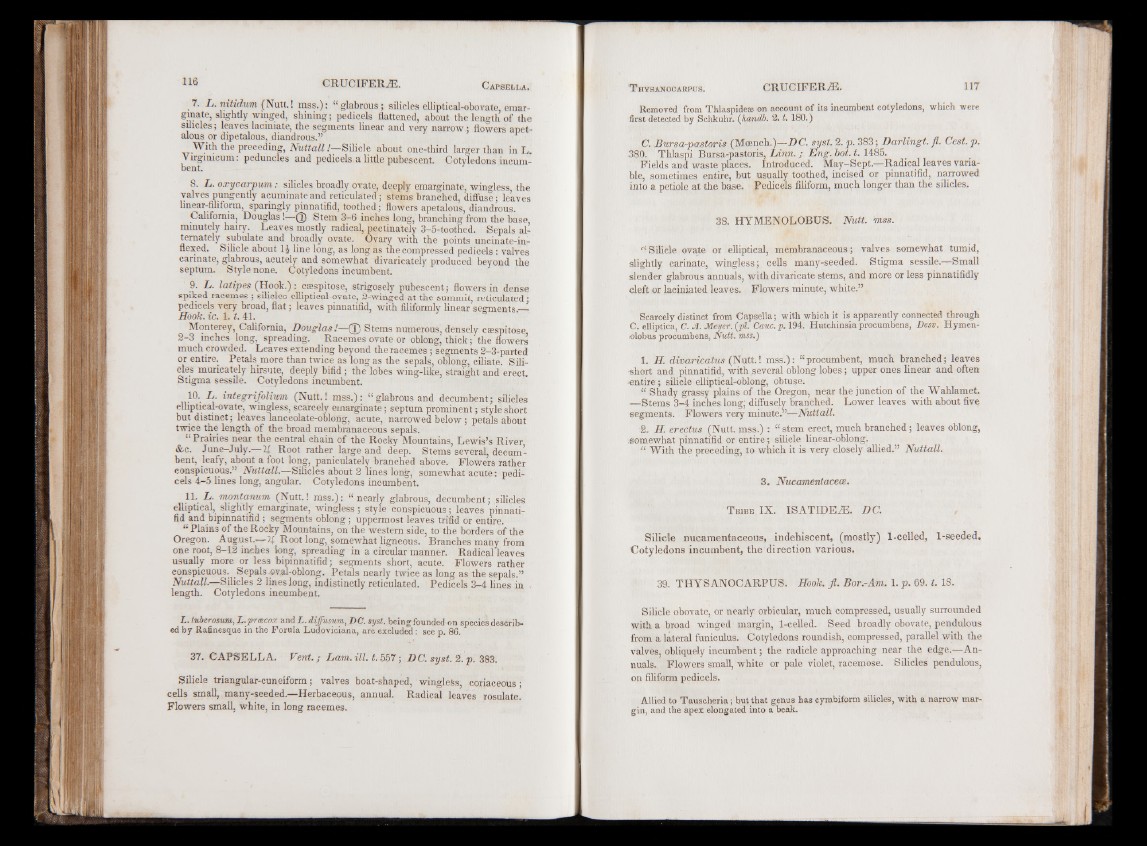
7. L. nitidum (Nutt.! mss.): “ glabrous; silicles elliptical-obovate emargmate,
slightly winged, shining; pedicels flattened, about the length of the
silicles; leaves laciniate, the segments linear and very narrow,j flowers apet-
alous or dipetalous, diandrous.” 1
With the preceding, Nuttall !—Silicle about one-third larger than in L.
Virginicum: peduncles and pedicels a little pubescent. Cotyledons incumbent.
8. L. oxycarpum: silicles broadly ovate, deeply emarginate, wingless, the
valves pungently acuminate and reticulated; stems branched, diffuse; leaves
linear-filiform, sparingly pinnatifid, toothed; flowers apetalous, diandrous.
California, Douglas!—(T) Stem 3-6 inches long, branching from the base
minutely hairy. Leaves mostly radical, pectinately 3-5-toothed. Sepals alternately
subulate and broadly ovate. Ovary with the points uncinate-in-
flexed. Silicle about l i line long, as long as the compressed pedicels : valves
carinate, glabrous, acutely and somewhat divaricately produced beyond the
septum. Style none. Cotyledons incumbent.
9. L. latipes (Hook.) : csespitose, strigosely pubescent; flowers in dense
spiked racemes ; silicles elliptical-ovate, 2-winged at the summit, reticulated;
pedicels very broad, flat; leaves pinnatifid, with filiformly linear segments.__
Hook. ic. 1 .t. 41.
Monterey, California, Douglas!—(J) Stems numerous, densely csespitose
2-3 inches long, spreading. Racemes ovate or oblong, thick; the flowers
much crowded. Leaves extending beyond the racemes ; segments 2-3-parted
or entire. Petals more than twice as long as the sepals, oblong, ciliate. Silicles
murieately hirsute, deeply bifid ; the lobes wing-like, straight and erect.
Stigma sessile. Cotyledons incumbent.
10. L. integrifolium (Nutt.! mss.): “ glabrous and decumbent; silicles
elliptical-ovate, wingless, scarcely emarginate; septum prominent; style short
but distinct; leaves lanceolate-oblong, acute, narrowed below; petals about
twice the length of the broad membranaceous sepals.
“ Prairies near the central chain of the Rocky Mountains, Lewis’s River
&c. June—July.— If Root rather large and deep. Stems several, decumbent,
leafy, about a foot long, paniculately branched above. Flowers rather
conspicuous.” Nuttall.—Silicles about 2 lines long, somewhat acute: pedicels
4-5 lines long, angular. Cotyledons incumbent.
U- L. montanum (Nutt.! mss.): “ nearly glabrous, decumbent; silicles
elliptical, slightly emarginate, wingless; style conspicuous; leaves pinnatifid
and bipinnatifid; segments oblong; uppermost leaves trifid or entire.
“ Plains of the Rocky Mountains, on the western side, to the borders of the
Oregon. August.— If Root long, somewhat ligneous. Branches many from
one root, 8-12 inehes long, spreading in a circular manner. Radical leaves
usually more or less bipinnatifid; segments short, acute. Flowers rather
conspicuous. Sepals .oval-oblong. Petals nearly twice as long as the sepals.”
Nuttall.—Silicles 2 lines long, indistinctly reticulated. Pedicels 3-4 lines in
length. Cotyledons incumbent.
L. tuberosum, L.pr&cox and L. dijfusu/m, DC. syst. beingfounded on species described
by Rafinesque in the Forula Ludoviciana, are excluded: see p. 86.
37. CAPSELLA. Vent.; Lam. ill. t. 557; DC. syst. 2. p. 383.
Silicle triangular-cuneiform; valves boat-shaped, wingless, coriaceous •
cells small, many-seeded.—Herbaceous, annual. Radical leaves rosulate.
Flowers small, white, in long racemes.
Removed from Thlaspide® on account of its incumbent cotyledons, which were
first detected by Schkuhr. (handb. 2. t. 180.)
C. Bursa-pastoris (Moench.)—DC. syst. 2. p. 383; DaTlingt.fl. Cest. p.
380. Thlaspi Bursa-pastoris, Linn. ; Eng. hot. t. 1485.
Fields and waste places. Introduced. May—Sept.—Radical leaves variable,
sometimes entire, but usually toothed, incised or pinnatifid, narrowed
into a petiole at the base. Pedicels filiform, much longer than the silicles.
38. HYMENOLOBUS. Nutt. mss.
“ Silicle ovate or elliptical, membranaceous; valves somewhat tumid,
slightly carinate, wingless; cells many-seeded. Stigma sessile.—Small
slender glabrous annuals, with divaricate stems, and more or less pinnatifidly
cleft or laciniated leaves. Flowers minute, white.”
Scarcely distinct from Capsella; with which it is apparently connected through
C. elliptica, C. A. Meyer, {pi. Cauc. p. 194. Hutchinsia procumbens, Desv. Hymen-
nlobus procumbens, Nutt, mss.)
1. H. divaricatus (Nutt.! mss.): “ procumbent, much branched; leaves
short and pinnatifid, with .several oblong lobes; upper ones linear and often
«entire ; silicle elliptical-oblong, obtuse,
“ Shady grassy plains of the Oregon, near the junction of the Wahlamet.
— Stems 3-4 inches long; diffusely branched. Lower leaves with about five
segments. Flowers very minute.”—Nuttall.
2. H. erectus (Nutt mss.) : “ stem erect, much branched; leaves oblong,
somewhat pinnatifid or entire; silicle linear-oblong.
“ With the preceding, to which it is very closely allied.” Nuttall.
3. Nucamentacece.
T ribe IX. ISATIDEÆ. DC.
Silicle nucamentaceous, indéhiscent, (mostly) 1-celled, 1-seeded.
Cotyledons incumbent, the direction various.
3 a THYSANOCARPUS. Hook. jl. Bor.-Am. L p. 69. t. 18.
Silicle obovate, or nearly orbicular, much compressed, usually surrounded
with a broad winged margin, 1-celled. Seed broadly obovate, pendulous
from a lateral funiculus. Cotyledons roundish, compressed, parallel with the
valves, obliquely incumbent; the radicle approaching near the edge.—Annuals.
Flowers small, white or pale violet, racemose. Silicles pendulous,
on filiform pedicels.
Allied to Tauscheria; but that genus has cymbiform silicles, with a narrow margin,
and the apex elongated into a beak.